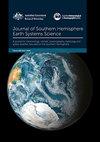布里斯班市区的高影响雷暴
IF 3.6
4区 地球科学
Q1 Earth and Planetary Sciences
引用次数: 1
摘要
雷暴发生前数小时至数分钟内的准确预警往往受到中尺度大气环境复杂演变的限制。为了准确地捕捉这些复杂性,对观测结果的分析仍然是雷暴短期临近预报的核心。在过去的40年中,多次高影响雷暴事件影响了昆士兰州东南部的布里斯班大都市区(BMA),造成了重大的保险损失。其中四个高影响事件是以下工作的重点。这些案例包括导致BMA最大保险损失的三个事件,超过40亿澳元(2017年)(1985年1月18日,2008年11月16日和2014年11月27日)和第四个重大事件(1989年12月24日)。综合以往的工作表明,这四个高影响案例发生在一个东南变化期间,在该变化之前风力增强,这表明可能存在可用于预测的共性。本文对四个BMA事件的环境和对流风暴进行了详细的观测分析,以探讨可能提高临近预报技能的判别特征。在四个BMA事件中,在变化到达布里斯班机场之前的几个小时内,沿着变化观察到明显的深层对流,可能作为高影响雷暴有利条件的早期指标。通过布里斯班的东南向变化的时间也与所有事件高度相关,发生在午后对流加热最大值的90分钟窗口内。尽管有破坏性的恶劣天气,但高空条件对于支持有组织的雷暴来说是次要的,这突出了捕捉中尺度过程的重要性,例如东南变化。为了进一步了解4次高影响BMA事件的可能判别因素,对11月至1月暖季月份的中尺度气候和与东南变化事件相关的天气环境进行了10年气候学研究。结果表明,虽然只有少数事件与高影响BMA雷暴有关,但这些事件都有一系列与变化前风移、东南变化时间和雷达特征有关的条件。本文章由计算机程序翻译,如有差异,请以英文原文为准。
High-impact thunderstorms of the Brisbane metropolitan area
Accurate thunderstorm warnings in the hours-to-minutes preceding impact are often limited by the complex evolution of the mesoscale atmospheric environment. To accurately capture these complexities, analysis of observations remained central to operational short-term nowcasting predictions of thunderstorms. Over the past 40 years, multiple highimpact thunderstorm events have impacted the Brisbane Metropolitan Area (BMA) of South East Queensland resulting in significant insured losses. Four of these high-impact events were the focus of the following work. These cases included three events that resulted in the greatest insured losses for the BMA, exceeding AU$4 billion (2017) (18 January 1985, 16 November 2008 and 27 November 2014) and a fourth significant event (24 December 1989). Synthesis of previous work indicates that the four high-impact cases occurred during a south-easterly change with strengthening winds ahead of the change, suggesting commonalities may exist that can be exploited for forecasting. This paper provides a detailed observational analysis of the environment and convective storms from the four BMA events to explore discriminating characteristics that may improve the skill of nowcasting. For the four BMA events, significant deep convection was observed along the change for the hours prior to the change’s arrival at the Brisbane Airport, potentially acting as an early indicator of favourable conditions for high-impact thunderstorms. It was found that the timing of the south-easterly change through Brisbane was also highly correlated for all events, occurring within a 90-min window during the mid-afternoon convective heating maximum. Despite the destructive severe weather, upper air conditions were marginal for supporting organised thunderstorms, highlighting the importance of capturing mesoscale processes, such as the south-easterly change. To further understand possible discriminators of the four high-impact BMA cases, a 10-year climatology of the mesoscale and synoptic environment associated with south-easterly change events was developed for the warm season months of November to January. It is shown that although only a small number of events are associated with high-impact BMA thunderstorms, these events share a set of conditions relating to the prechange wind shift, timing of the south-easterly change and radar signatures.
求助全文
通过发布文献求助,成功后即可免费获取论文全文。
去求助
来源期刊

Journal of Southern Hemisphere Earth Systems Science
Earth and Planetary Sciences-Oceanography
CiteScore
8.10
自引率
8.30%
发文量
0
审稿时长
>12 weeks
期刊介绍:
The Journal of Southern Hemisphere Earth Systems Science (JSHESS) publishes broad areas of research with a distinct emphasis on the Southern Hemisphere. The scope of the Journal encompasses the study of the mean state, variability and change of the atmosphere, oceans, and land surface, including the cryosphere, from hemispheric to regional scales.
general circulation of the atmosphere and oceans,
climate change and variability ,
climate impacts,
climate modelling ,
past change in the climate system including palaeoclimate variability,
atmospheric dynamics,
synoptic meteorology,
mesoscale meteorology and severe weather,
tropical meteorology,
observation systems,
remote sensing of atmospheric, oceanic and land surface processes,
weather, climate and ocean prediction,
atmospheric and oceanic composition and chemistry,
physical oceanography,
air‐sea interactions,
coastal zone processes,
hydrology,
cryosphere‐atmosphere interactions,
land surface‐atmosphere interactions,
space weather, including impacts and mitigation on technology,
ionospheric, magnetospheric, auroral and space physics,
data assimilation applied to the above subject areas .
Authors are encouraged to contact the Editor for specific advice on whether the subject matter of a proposed submission is appropriate for the Journal of Southern Hemisphere Earth Systems Science.
 求助内容:
求助内容: 应助结果提醒方式:
应助结果提醒方式:


